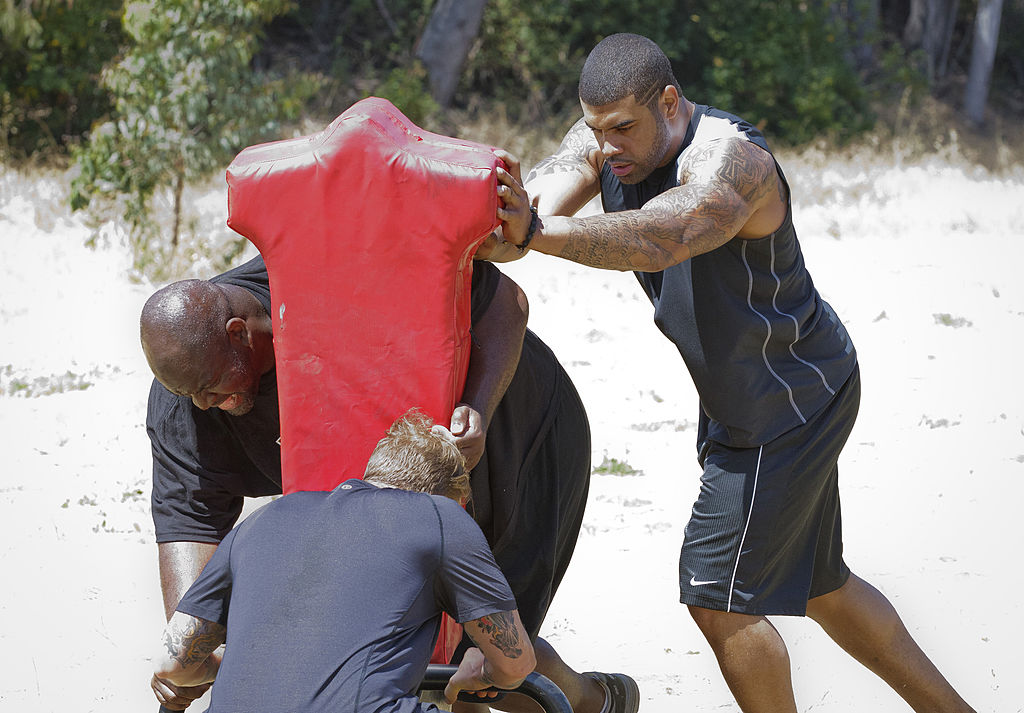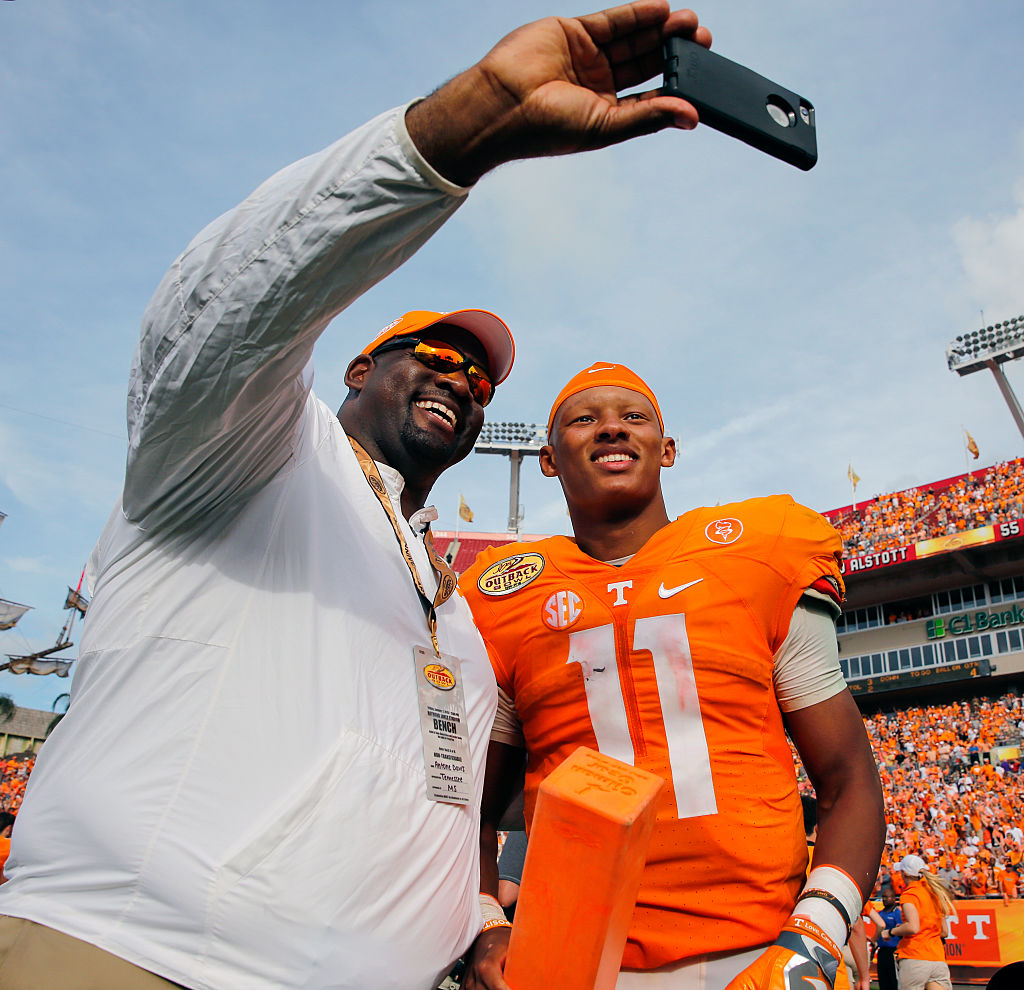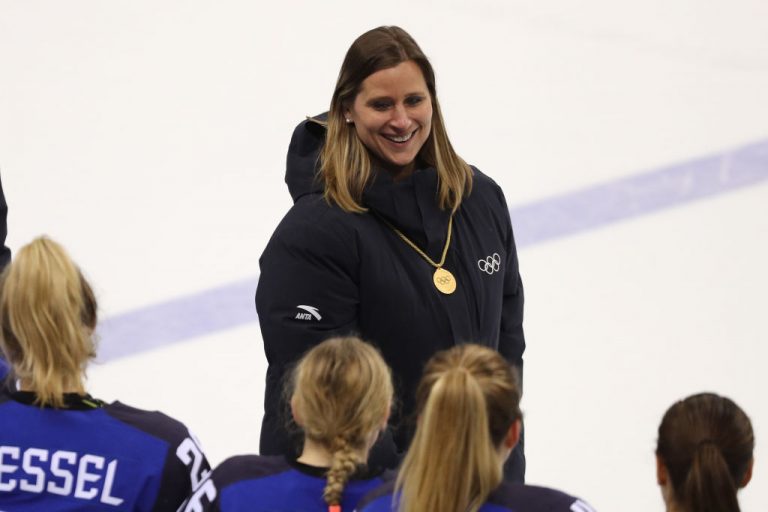‘A Big Struggle’: In Retirement, Athletes Can Face a Jarring Physical Transition
Why this matters
When the lights go out and the cheering stops, athletes in all sports are often left with bodies and habits that no longer fit their lives—and that leave the athletes to battle everything from body dysmorphia to weight fluctuations on their own. But recently the conversation around post-retirement health has become louder and more inclusive.
They were the least likely of jogging partners, the shrinking former offensive lineman and the retired Olympic speed skater, but there they were, making their way down a path on a ranch near Malibu, California. One man wanted to run a marathon. The other was astonished to be running at all.
In 2011, Antone Davis was one of 15 contestants on NBC’s “The Biggest Loser.” The reality show was going to snap the former Philadelphia Eagles and Atlanta Falcons tackle into shape, help him build better habits and shed the pounds he’d packed on since retirement. And he was ready to exert some control over his health—in large part because he was terrified.
Fourteen years removed from his final National Football League game, Davis weighed more than 450 pounds, and he could no longer ignore the stories he was hearing about former linemen, guys like him, dying young. As one of the heaviest men in America’s heaviest sport, he felt vulnerable, as though his career had left him uniquely unprepared to move and eat and exist in the real world.
And then he ran with Apolo Ohno.
The eight-time Olympic medalist had retired a year earlier, and on the ranch that day, he told Davis his muscle-bound thighs, so crucial to his success on the ice, made him a terrible runner. Now that he was finished skating, he wanted to complete a marathon, to become longer and more limber. And though Ohno appeared as a guest on only one episode of the show, his presence left a lasting mark on Davis.
He wasn’t alone. It wasn’t just him. It wasn’t just linemen. Athletes from all sports experienced some version of his post-career slog, the feeling that their bodies no longer fit their lives.
Related: Going Full-Circle On The Post Sport Journey
For years, Davis had operated at extremes of size and strength and just about everything else. So do most elite athletes. In the glare of the spotlight, they learn half-truths about their bodies and how to deploy them. They listen to cues, to orders, from coaches and trainers, fans, and faceless commenters who have everything but their best interests at heart. Smile wider. Suck it in. Eat a pie. Bench-press a Cadillac.
But after the last contract is ripped to shreds and the scholarship has run out, many athletes don’t have a clue how to achieve the bodies they need – not for sports, but for life. Some know they must gain weight but balk at the prospect. Others pray they’ll learn to keep it off. Many feel powerless to achieve their goals, or even to set them, as habits that were once necessary become impractical, as rest becomes tempting, diets cumbersome.
And without a team, without the structures they’ve molded their bodies to fit neatly inside, retired athletes are left to their own devices. Spat out by a billion-dollar industry, they battle everything from chronic injuries to body dysmorphia and from hormonal imbalances to weight fluctuations, often feeling isolated in the process. But as the conversation around post-retirement health gets louder and more inclusive, perhaps a football player might learn from a speed skater, a new generation from past mistakes.
Antone Davis played his first snap of competitive football at Peach County High School in central Georgia in 1985 – as a senior. Before that, the man who would become the eighth pick in the 1991 NFL draft had been simply too small to play. He stood 5 feet, 11 inches and weighed 175 pounds his junior year, but in a matter of months, he shot up six inches and added 130 pounds to his frame.
“I have six brothers and one sister, and I used to joke that I would be handing up my clothes as opposed to taking hand-me-downs,” he says. “It was just bizarre. I never expected it. I don’t really have an explanation for how it happened.”
But football recruiters didn’t need an explanation. Davis played one year of prep-school ball after graduation, transforming into a prized recruit. At Tennessee Military Academy, he gained 45 pounds, and then he was off to the University of Tennessee. Volunteers coaches had one stipulation when he signed: He needed to drop back down to his high school playing weight.
It was then, in the swampy Knoxville summer, that a lifetime of bad habits was born.

Davis learned how to cut water weight, even if it put him at risk for dehydration. He learned to eat 5,000 calories a day, 6,000, 7,000. In the NFL, it was more of the same. “Different teams had different requirements,” he recalls. “Some teams liked for you to be thin, … if there is such a thing as a slim and trim offensive lineman, whereas some coaches and other teams wanted you to be as big as you could be but still be able to run.”
In five years with the Philadelphia Eagles and two with the Atlanta Falcons, Davis was at the whims of coaches, who set his playing weight with little more than a glance. “A coach would look at you and say, ‘You need to be 320,’” Davis recalls. “Well, there’s really no science behind that other than [he thinks] you look good at 320, and you don’t look at 325.” And so he’d spend an afternoon in the sauna, sweating off the excess, or he’d gorge himself to meet an arbitrary standard. His weight dipped as low as 325 in the pros and climbed as high as 375, and when he retired, he was exhausted.
Davis moved to Orlando. He opened a restaurant. He got back in the gym sometimes, lifting weights, hearing old coaches’ refrains about strength training being superior to cardio. “I got on the scale one day, and [I weighed] 476 pounds,” he says. “I’m sitting here going, ‘I don’t know what to do.’”
That was in 2010, right before he got an email from producers at “The Biggest Loser.” They were looking for a retired athlete to participate during an upcoming season. Davis would learn later that he was chosen over several other ex-NFLers, all of them defensive backs and receivers. He was shocked. He’d never expected guys who’d played at half his weight, who could sprint and cut and dance through the most fleeting of gaps, might be dealing with the same problems he was.
Now, he knows better.
When Kate Ackerman arrived at Cornell University as a freshman in 1990, she had her sights set on making one of the campus a cappella groups. She’d done musical theater in high school, but after auditions, she learned she hadn’t earned a spot. “Well, I guess I can’t sing,” Ackerman recalls thinking. “So what can I try? I stumbled into the boathouse, wasn’t very good, caught the bug, and got better.”
Ackerman competed on Cornell’s crew teams for four years, and as she threw herself into training, her academic interests also solidified. She switched her major to pre-med, and when she graduated, she took two years to prepare for the MCAT and apply to medical school. In that time, she lost a few pounds and attended a pre-elite lightweight training camp, which was her first foray into the most competitive realm of her sport. Then, in 1997, the year after she enrolled at Johns Hopkins University for medical school, she made the national rowing team. She drove from Baltimore, Maryland, to Washington, D.C., every weekend to train and managed to stay in peak physical form while studying harder than she ever had before. And though Ackerman missed the cut for the 2000 Olympic team, by then, she had a new goal: One day, she was going to be the team physician for US Rowing.
One residency, two fellowships, and a master’s degree in public health later, Ackerman scored that dream job. In fact, she has scored a few over the years. In addition to working with elite rowers, she also sees sports medicine patients at Boston Children’s Hospital, where she runs the pioneering Female Athlete Program.
Ackerman wants to break the stereotypes around retired athletes’ health. In a world where men make outsized paychecks compared to women’s pay, where men have 100 times the opportunities and resources, stories like Davis’s have become the norm. Male athletes who’ve lost weight – or failed to lose it – dominate the narrative around retired athlete health. Nick Hardwick, the former San Diego Chargers center, lost 85 pounds and made headline news. Former Chicago Bears defensive tackle and 1980s pop culture icon William “The Refrigerator” Perry, having added pound after pound of weight in retirement to his already massive frame, became a cautionary tale.
But Ackerman wants people to think bigger, to realize such stories are part of a larger canon, one that includes everyone from distance runners whose knees have gone bad to gymnasts who have such low body fat at retirement that they’ve lost their menstrual periods.
“Certainly athletes, most of them struggle with body image issues,” she says. “They've been in amazing shape and felt really good, and people probably made all sorts of objectifying comments about how great they look. And then they’re not sure if they can keep that up, or if they want to keep it up. Then they feel bad that they didn’t keep it up, and then they start putting self-worth into it. It’s a big struggle that people don’t talk enough about.”
Ackerman went through that struggle herself, eating and drinking with abandon after she retired from competitive crew. Her weight ticked back toward what it had been in college, then higher. Eventually, she got back on track by interrogating what her mind and body craved. Was it competition? Crew? Something totally different? She settled on a mixture of rowing with friends and working with a personal trainer.
Related: Redesigning the System: How Trans and Non-Binary Athletes Are Transforming Sport
Over the years, Ackerman has had to fight to be heard, but she’s made real headway in improving the medical literature about female athletes, which she finds woefully lacking. Two decades ago, she pitched a study of retired female Olympic athletes to learn about their post-career struggles. The U.S. Olympic Committee representative she spoke with at the time expressed disinterest and concern that the findings would discourage women from competing. But the doctor bided her time, and earlier this year, she became a consultant for the U.S. Olympic and Paralympic Committee and began to develop a research agenda for female athletes. “Twenty years later, yes, we’re doing it,” Ackerman says, “and people have a much more open mind.”
People are increasingly willing to see the struggle across all sports, to listen to a trim woman or svelte man share their story and give it equal weight to Davis’s. And Katie Spada, a retired synchronized swimmer who now works as a registered dietitian in Las Vegas and runs a program for former athletes, thinks those stories might be the key to progress.
“The more that we get people talking about how challenging the transition is, there is more of a push to help prepare athletes for that,” she says.
Competing at Ohio State, Spada trained four hours a day, both on land and in the water. She pushed her body to be something it wasn’t, to be thinner than it should’ve been. Synchronized swimming, like most sports, involves a curated aesthetic, which she felt constant pressure to meet for more than a decade. And when she retired, she maintained a grueling workout regime in the pool, forcing her body to perform in ways it didn’t need to, in ways it shouldn’t.
“I needed to train my body for activities of daily living,” Spada says. “And same thing with food; I was still treating food as only fuel. Since I wasn’t working out as much, I wasn’t eating as much. I severely under-ate.”
But due to a hormonal imbalance, she didn’t lose weight. She actually put on a few pounds. It was only after working with medical professionals and learning how to eat intuitively that she regulated, and when she did, she realized she no longer had much interest in the pool. Now, she teaches barre classes.
Spada knows her experience is unique, that it’s impossible to generalize across her roster of clients – but she also has developed a few pieces of universal wisdom. With nearly every retired athlete, she breaks down nutritional misconceptions: that white potatoes are as healthy as sweet potatoes, that fats and carbs are as important as protein. She teaches them to listen to their bodies rather than just look at them and push them. And she helps clients determine what type of fitness they actually enjoy, what might be a path to the healthy body they desire.
“I try and always emphasize with athletes [that] this is going to take some time,” she says. “We're basically retraining your brain to think about food, exercise, movement, even goal-setting. It’s totally different.”
When Davis arrived in California to film “The Biggest Loser,” he was motivated and willing to buy in. He ate clean and spent hours roaming the ranch where the show is shot, venturing up inclines and eventually even breaking out into a jog. He did resistance training and worked with kettlebells, and he doesn’t think he ever lifted more than 25 pounds. “The biggest aha moment,” he says, “was walking.” Davis had never considered that getting in shape could be so simple, so methodical, so focused around an ingrained movement he hadn’t been doing nearly enough.
In his first six weeks on the show, Davis shed 101 pounds. By the end, he was down to 245, and over the course of filming, he sliced his BMI nearly in half, from 53 to 29.1. In the finale, where the competitor who’s lost the greatest percentage of his or her body fat takes home $250,000, Davis narrowly lost, placing second overall.
He was healthier than he’d been since that long-ago growth spurt, but the results didn’t last. Leaving the show wasn’t all that different from retiring: Suddenly, Davis had to negotiate a new environment, one where he’d never lived the way he’d been living on the ranch.
“I have four kids, right, and they were very young,” he says. “When you're on the show, you miss your kids a lot, and you want to do the things you always do with your kids. Part of that includes, hey, let’s go get an ice cream, … and I didn’t believe my kids needed to be on the diet with me.”
So Davis got less rigid. Over the years, he’s gained some of the pounds back, bit by bit, handful of popcorn by slice of cheesecake. He declines to give his current weight – “I’m just not happy with where I am,” he says – but he feels better than he did before.
Davis speaks about weight loss like it’s the loneliest thing a person can do. He wishes he’d started sooner. He struggles with the idea of working with a trainer or coach, wary of letting someone in. And he never talks about the challenges he faces with his former teammates, with guys he knows are experiencing the exact same thing.
That’s the thing about these stories: They’re not always a binary between happy endings and tragic ones. Sometimes, they’re just about people doing their best, setting an imperfect example, adding to the conversation.
And speaking of endings, Davis isn’t ready for his, not yet. Lately, he’s been thinking about moderation, an elusive concept for a man accustomed to locker rooms and television cameras. If he does give weight loss another go, he says, that’s what he’ll strive for. He’ll take his cues not from a camera, not from a coach with little concern for his future, but from his own body. It’s gotten him this far.
Monthly Issue
The Athlete's Journey
If you are what you repeatedly do, what happens when you stop doing it?
The athlete's journey outside of competition is not often covered in media, nor considered all that much by fans. It can, however, be core to athletes’ lived experiences, impacting decisions on where to play, which business opportunities to take, how to take care of their physical and mental health and more.




